List of Contents
Voice over Internet Protocol (VoIP) Market Size and Forecast 2025 to 2034
The global voice over internet protocol (VoIP) market size accounted for USD 145.70 billion in 2024 and is predicted to increase from USD 161.79 billion in 2025 to approximately USD 415.20 billion by 2034, expanding at a CAGR of 11.04% from 2025 to 2034. The growth of the market can be attributed to the increasing demand for cost-effective, flexible, and high-quality communication solutions.
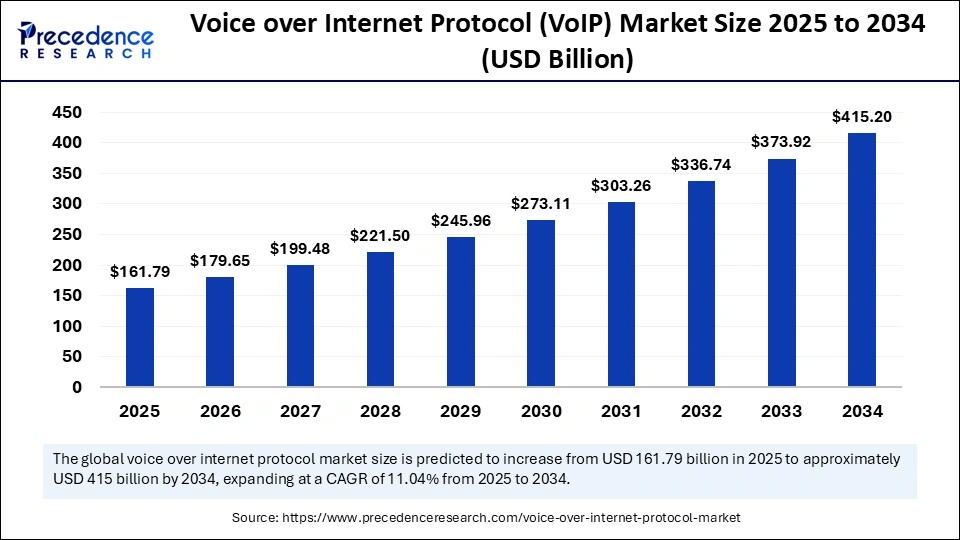
Voice over Internet Protocol (VoIP) Market Key Takeaways
- In terms of revenue, the voice over internet protocol (VoIP) market is valued at $161.79 billion in 2025.
- It is projected to reach $415.20 billion by 2034.
- The market is expected to grow at a CAGR of 11.04% from 2025 to 2034.
- North America dominated the voice over internet protocol (VoIP) market with the largest revenue share of 48% in 2024.
- Asia Pacific is expected to expand at the fastest CAGR during the forecast period.
- By service, the SIP trunking segment contributed the the highest revenue share of 46% in 2024.
- By service, the hosted IP PBX segment is expected to witness the fastest growth during the predicted timeframe.
- By enterprise size, the large enterprises segment dominated the market in 2024.
- By enterprise size, the small and medium-sized enterprises (SMEs) segment is expected to grow at the fastest rate during the forecast period.
- By end-user, the industrial/commercial segment dominated the market in 2024.
- By end-user, the residential segment is expected to expand at the highest CAGR in the coming years.
Can AI-driven Anomaly Detection Models Improve VoIP Security Against Fraud and Cyberattacks?
Through constant network traffic monitoring, AI-driven anomaly detection models improve VoIP security by spotting odd things that might point to fraud or cyberattacks. AI models enable quick identification of threats like toll fraud and denial-of-service (DoS) attacks by analyzing behaviors like abrupt spikes in call volumes, unauthorized access attempts, and irregular call routing in real-time. AI considerably lowers false positives and enables proactive threat identification by learning typical user behavior and more accurately flagging deviations than traditional rule-based systems.
Without the need for human intervention, AI systems can minimize possible harm by automatically blocking or rerouting suspicious traffic in response to detected anomalies. To safeguard users and service providers from financial and privacy risks, they are also essential to stop fraud types like robocalls, call hijacking, and spoofing. AI-driven anomaly detection models are becoming essential tools for protecting contemporary VoIP communications because of their capacity to grow with rising VoIP usage and adjust to changing attack techniques.
What Is the Future Market Size of VoIP in the United States?
According to Precedence Research, the U.S. voice over internet protocol (VoIP) market size was valued at USD 52.45 billion in 2024 and is expected to reach around USD 152.04 billion by 2034. It is poised to grow at a double-digit CAGR of 11.22% during the forecast period from 2025 to 2034.
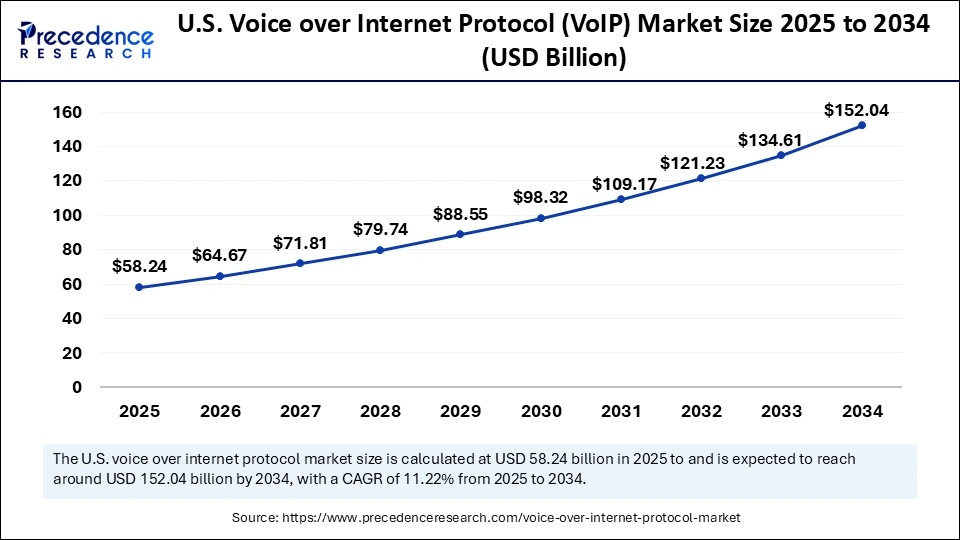
North America dominated the voice over internet protocol (VoIP) market by capturing the largest share in 2024. This is mainly due to the early adoption of cloud-based communication and the widespread availability of high-speed internet. The availability of sophisticated telecom infrastructure further bolstered the market in the region. Major industry participants and robust demand from home and business users support the region's continued leadership. VoIP is being used by North American businesses more and more in conjunction with AI and unified communications tools to improve customer service and collaboration. The use of IP-based voice solutions is further fueled by investments made by the public and private sectors in digital transformation. Additionally, businesses of all sizes now need VoIP due to the remote and hybrid work cultures.
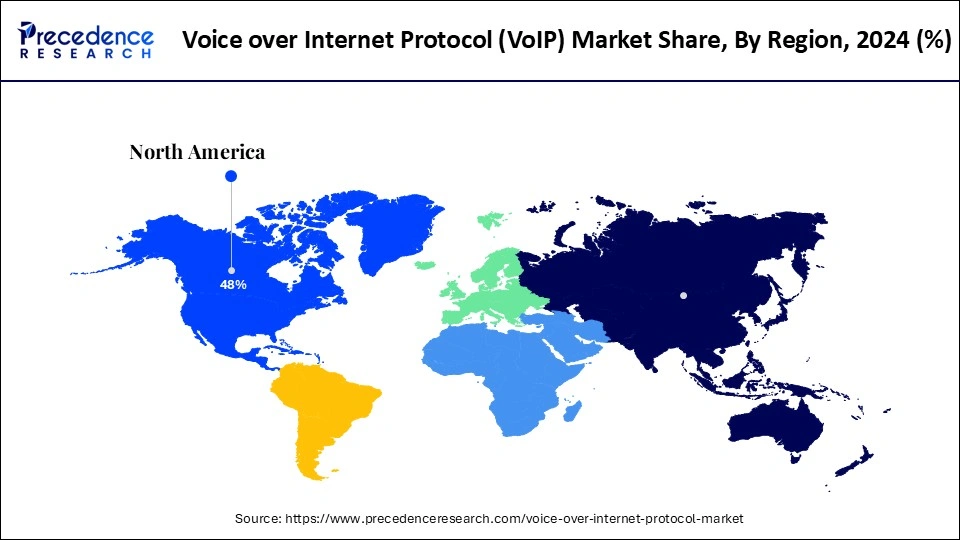
Asia Pacific is expected to witness the fastest growth in the upcoming years, driven by growing broadband access, the emergence of a remote work culture, and the rapid pace of digital transformation. VoIP is being adopted by startups and SMEs due to its scalability and cost-effectiveness. The adoption of app-based VoIP platforms is rising in the region due to the increasing smartphone usage and the growing number of people who prefer mobile devices. The quality and dependability of VoIP calls are being improved by the countries in these regions through investments in 5G and fiber optic networks. Furthermore, cross-border VoIP communications are being promoted by an increase in outsourcing and global business operations.
Europe is expected to grow at a considerable rate in the upcoming period, backed by robust legal frameworks, consistent business demand, and rising investments in unified communication systems. To cut expenses and increase flexibility, companies throughout the region are switching from traditional PBX systems to IP-based alternatives. The need for secure communication tools that comply with GDPR is rising in industries like healthcare and finance, creating the need for VoIP services. Furthermore, the growth of e-learning and remote work is increasing the use of VoIP among several industries.
Market Overview
The voice over internet protocol (VoIP) market is witnessing significant growth, driven by an increasing need for communication solutions that are adaptable, scalable, and affordable. To facilitate remote work, improve collaboration, and lower infrastructure costs, businesses are slowly moving away from traditional telephony systems and toward cloud-based VoIP platforms. VoIP services are becoming even more alluring thanks to technological developments like AI-powered voice assistants' real-time language translation and integration with CRM software. Furthermore, the emergence of unified communication platforms and mobile-first strategies is facilitating seamless device connectivity, which is propelling wider adoption across consumer and enterprise segments.
Key Characteristics and Benefits of Different VoIP Services
| VoIP Services | Key Features | Business Benefits |
| Hosted IP PBX | Cloud hosted, easy deployment, scalable | Low upfront cost, remote management |
| SIP Trunking | Connects PBX to the internet, flexible call routing | Cost savings, enhanced disaster recovery |
| Managed IP PBX | On-premises or hosted, fully managed service | Customizable reliable support |
What are the Key Trends in the Voice over Internet Protocol (VoIP) Market?
- Cost-Efficient: VoIP significantly reduces communication costs for businesses and individuals.
- Remote Work Trend: Rising adoption of remote and hybrid work models boosts VoIP usage.
- Advancements in Internet Infrastructure: Faster and more reliable internet supports better VoIP performance.
- Integration with Unified Communications: VoIP is part of broader unified communication platforms (e.g., video, messaging)
- Smartphones & Apps Proliferation: Widespread use of smartphones and VoIP apps (like Zoom, Skype, WhatsApp) boosts the growth of the market.
Market Scope
| Report Coverage | Details |
| Market Size by 2034 | USD 415.20 Billion |
| Market Size in 2025 | USD 161.79 Billion |
| Market Size in 2024 | USD 145.70 Billion |
| Market Growth Rate from 2025 to 2034 | CAGR of 11.04% |
| Dominating Region | North America |
| Fastest Growing Region | Asia Pacific |
| Base Year | 2024 |
| Forecast Period | 2025 to 2034 |
| Segments Covered | Service, Enterprise Type, End User and Region |
| Regions Covered | North America, Europe, Asia-Pacific, Latin America, and Middle East & Africa |
Market Dynamics
Drivers
Growing Need for Affordable and Flexible Communication Solutions
The need for affordable and flexible communication solutions is rising, which is a key factor driving the growth of the voice over internet protocol (VoIP) market. Conventional phone systems are less appealing, particularly for small and medium-sized enterprises, because they frequently require expensive infrastructure and maintenance costs. By leveraging current internet connections, VoIP significantly lowers these expenses, making it affordable for businesses of all sizes. VoIP services also provide subscription plans and flexible pricing structures to meet various business requirements, enabling companies to only pay for the services they use. Global VoIP adoption is accelerating due to its affordability and flexibility.
Expansion of High-speed Internet and 5G Networks
VoIP performance depends on the availability of 5G connectivity and high-speed broadband, which guarantee latency-free, high-quality voice and video transmission. More bandwidth and ultra-low latency are supported by 5G networks, in particular allowing for richer communication experiences like HD video conferencing and real-time collaboration. VoIP services are becoming more dependable and accessible as internet infrastructure around the world advances, which promotes wider adoption in both urban and rural areas. New technologies like VoIP integration with IoT are also supported by this infrastructure expansion.
Restraints
Dependence on Internet Quality and Connectivity
VoIP calls need low latency and steady internet bandwidth to preserve voice clarity. Reliability is decreased when users experience dropped calls and delays due to weak or unstable internet infrastructure. VoIP is, therefore, less appealing for important communications in rural or remote areas. Additionally, VoIP call quality may decline during periods of high network congestion, which could affect customer satisfaction and business operations.
Security and Privacy Concerns
VoIP is vulnerable to online threats, such as phishing, toll fraud, and data interception, because it sends voice data. To secure communications, organizations need to invest in firewalls, end-to-end encryption, and secure VoIP gateways. Furthermore, the possibility of illegal access to private discussions may be a deterrent, particularly for industries that handle sensitive data such as healthcare and finance. VoIP deployment is further complicated by the need to ensure compliance with international data protection laws.
Opportunities
Growing Adoption of Remote and Hybrid Work Models
Reliable internet-based communication tools are in high demand due to the growing trend toward remote and hybrid work environments. VoIP is an essential technology for companies adjusting to flexible work schedules because it facilitates smooth virtual collaboration. VoIP is being invested in by businesses to improve worker connectivity and productivity, creating new revenue streams for providers.
Demand for Unified Communication and Collaboration Platforms
The rising demand for unified communication platforms creates immense opportunities in the voice over internet protocol (VoIP) market. Businesses are searching for integrated platforms that integrate file sharing, video, voice, and messaging to increase productivity and streamline processes. VoIP companies can profit from this by providing all-inclusive solutions that satisfy changing demands for business communication. These convergence facilities improved customer interaction and remote teamwork.
By Service Analysis
Why Is SIP Trunking Leading the VoIP Market in 2024?
The SIP trunking segment dominated the voice over internet protocol (VoIP) market with the largest share in 2024. This is mainly due to the increased need for high-quality, adaptable voice solutions that work well with current PBX systems. SIP trunking lowers expenses while enhancing call quality and scalability. Its ability to facilitate business continuity, remote work, and smooth international market expansion makes it very appealing. SIP trunking is being adopted by businesses more frequently as a component of their digital transformation plans. Additionally, by promptly rerouting calls during emergencies or outages, it improves disaster recovery capabilities.
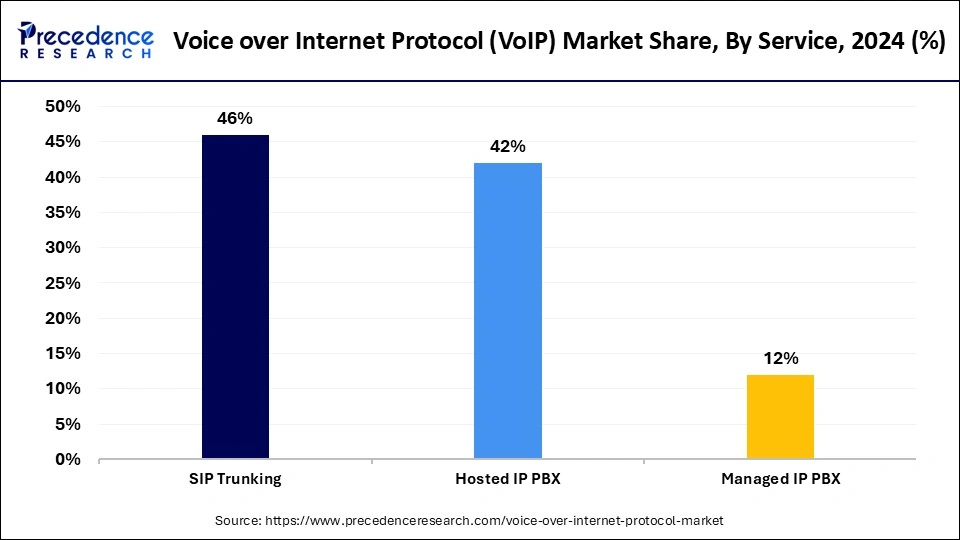
The hosted IP PBX segment is expected to witness the fastest growth during the predicted timeframe, driven by its easy deployment, high scalability, and affordability, especially for small and medium-sized businesses. To avoid the hassle and expense of maintaining on-premises hardware, businesses favor hosted solutions. With minimal IT expenditure, these systems enable centralized management, remote access, and simple upgrades. As the need for unified communication grows, hosted IP PBXs are being more and more integrated with team collaboration platforms and CRM software. Service providers also provide adaptable pricing structures to accommodate different business requirements, which encourages adoption even more.
By Enterprise Size Analysis
Why Are Large Enterprises Driving Growth in the VoIP Market in 2024?
The large enterprises segment held the largest share of the voice over internet protocol (VoIP) market in 2024. This is mainly due to the increased need for integrated and scalable communication platforms for worldwide operations. To facilitate hybrid work, multi-site connectivity, and real-time collaboration, large enterprises invest heavily in cutting-edge VoIP solutions like SIP trunking and unified communications. Vendors are being forced to create enterprise-grade features due to the high demand for safe, legal, and customized systems. Greater funding for digital transformation is causing big businesses to quickly replace outdated systems with contemporary VoIP infrastructure.
The small and medium-sized enterprises (SMEs) segment is expected to grow at the fastest rate during the forecast period. SMEs heavily invest in VoIP services to lower operating costs. These enterprises are embracing cloud-based communication solutions more and more. Because of their low infrastructure requirements, flexibility, and affordability, hosted VoIP services are perfect for companies with little IT staff. Features like remote access, auto attendants, and virtual numbers are advantageous to SMEs without requiring a significant initial investment. The availability of pricing models based on subscriptions encourages small businesses to adopt them widely.
By End-User Analysis
Why Is the Industrial and Commercial Sector Leading VoIP Adoption in 2024?
The industrial/commercial segment led the voice over internet protocol (VoIP) market in 2024 due to the increased need for cloud-based integrated communication platforms in the IT & telecom industry. VoIP systems that are dependable, scalable, and feature-rich are necessary for various industries to support global operations, customer service, and remote workforces. While telecom companies are trying to attract enterprise clients by expanding their VoIP offerings, IT companies are incorporating VoIP into more comprehensive digital solutions. The demand for VoIP services is growing in the industrial sector due to the drive for unified communications and digital transformation.
The residential segment is expected to expand at the highest CAGR in the coming years because more people are using internet-based calling for private conversations. People are switching from traditional landlines to VoIP apps and services as a result of the availability of inexpensive broadband and mobile internet. Popular apps like Viber, WhatsApp, and Skype have reduced the cost and increased accessibility to long-distance and international calling. Furthermore, ISPs that bundle VoIP services are encouraging adoption in the residential sector.
Voice over Internet Protocol (VoIP) Market Companies
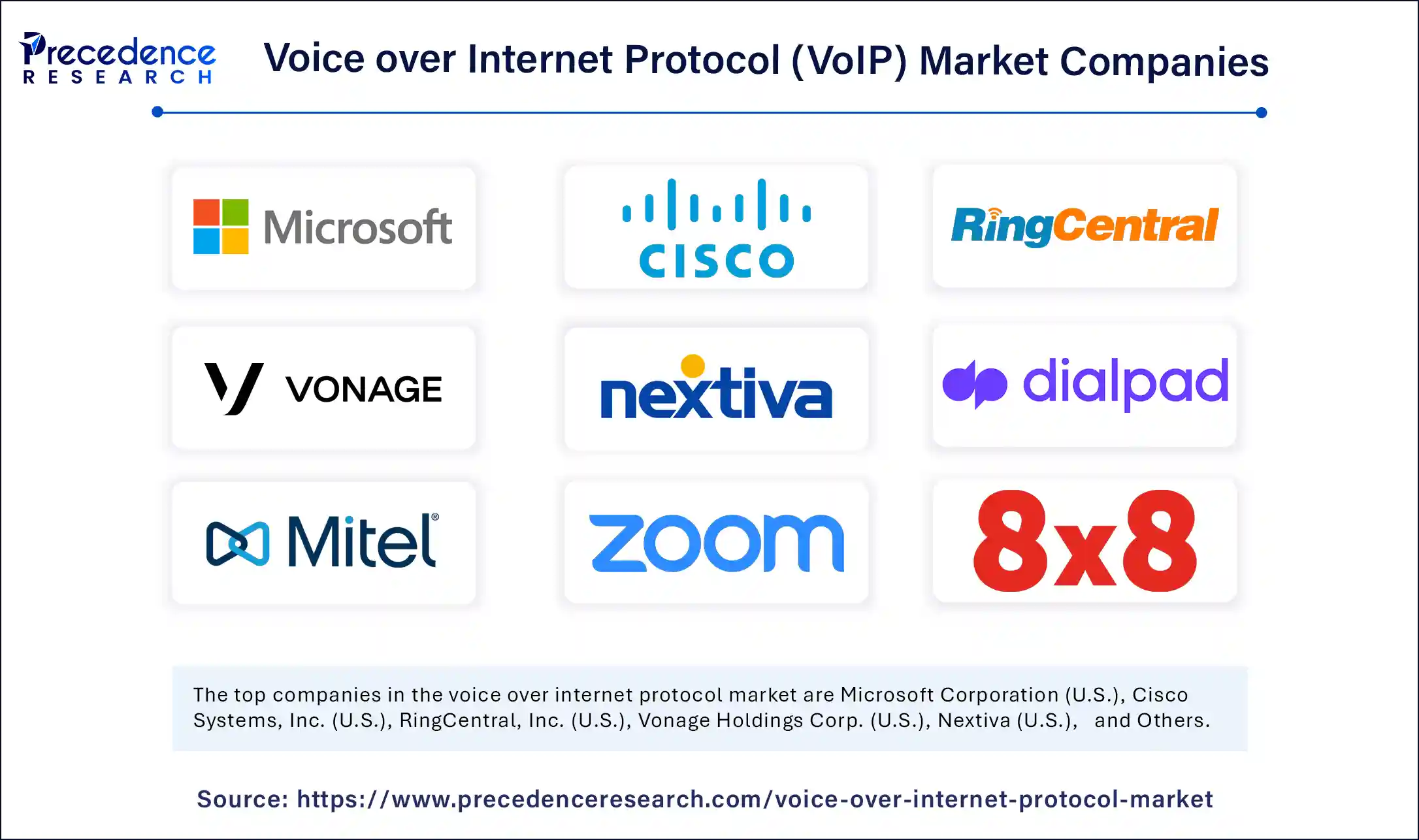
- Microsoft Corporation (U.S.)
- Cisco Systems, Inc. (U.S.)
- RingCentral, Inc. (U.S.)
- Vonage Holdings Corp. (U.S.)
- Nextiva (U.S.)
- Dialpad, Inc. (U.S.)
- Mitel Networks Corp. (Canada)
- Zoom Video Communications, Inc. (U.S.)
- 8*8 Inc. (U.S.)
- AT&T Intellectual Property (U.S.)
- Grasshopper (U.S.)
- Ooma, Inc. (U.S.)
- Go TO (U.S.)
- Verizon Corporation (U.S.)
- InPhonex LLC (U.S.)
- 3CX (Cyprus)
- Xorcom (U.S.)
- ASTEC Communications Pvt. Ltd. (India)
- HoduSoft (India)
- IQ Infotech (India)
Latest Announcements
- On 5 March 2024, Microsoft integrated Copilot AI features into Microsoft Teams, enhancing collaboration with intelligent assistance. CEO Satya Nadella commented, “AI is the future of productivity, and integrating Copilot into Teams enables smarter and more efficient communication. (Source: https://www.bloomberg.com)
- On 20 February 2024, 8x8 launched an updated XCaaS platform, combining voice, video, chat, and contact center services into a unified solution. CEO Dave Sipes emphasized, “By continuing to innovate across our 8X8 XCaaS platform, we help organizations optimize employee and customer experience, regardless of location or device.”(Source: https://www.sec.gov)
Recent Developments
- On 4 March 2025, Alianza, a cloud native communications platform provider, finalized its acquisition of Metaswitch, a move aimed at empowering service providers to modernize their networks and close significant gaps in services revenue. The combined offering will enable over 1,000 service providers, including 19 of the top 20 global operators, to transition from legal infrastructure to AI-powered, cloud-based communications solutions. This strategic acquisition positions Alianza to offer a unified product portfolio that enhances operational efficiency and customer experience. (Source: https://www.alianza.com)
- In January 2025, Zoom Phone gained recognition for its secure, scalable VoIP platform. Its AI tools and global connectivity enhanced its reputation in 2025. Zoom continues to dominate cloud communications with strong enterprise adoption. (Source: https://www.zoom.com)
Segments Covered in the Report
By Service
- SIP Trunking
- Hosted IP PBX
- Managed IP PBX
By Service
- Small and Medium Enterprises (SMEs)
- Large Enterprises
By End-user
- Residential
- Industrial/Commercial
- BFSI
- IT & Telecom
- Healthcare
- Retail & E-commerce
- Education
- Manufacturing
- Government
- Oil & Gas
- Others (Media & Entertainment)
By Region
- North America
- Europe
- Asia Pacific
- Latin America
- Middle East & Africa
For inquiries regarding discounts, bulk purchases, or customization requests, please contact us at sales@precedenceresearch.com
Frequently Asked Questions
Ask For Sample
No cookie-cutter, only authentic analysis – take the 1st step to become a Precedence Research client